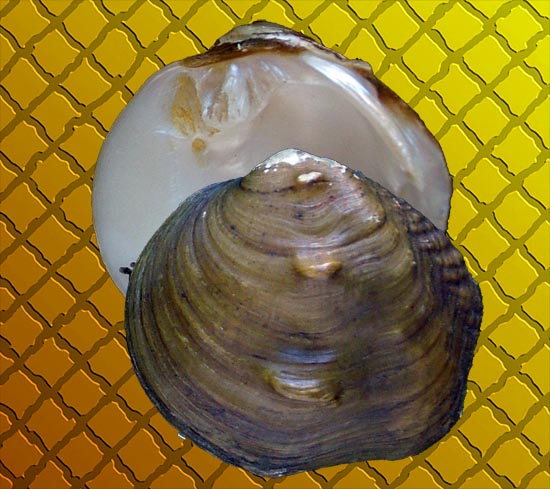| Page last updated
3 May 2010 |
Mussel of the Month
The May 2010 Mussel of the Month is Obliquaria reflexa. Obliquaria is a monotypic genus from eastern North America.

ANSP 20206. Lefart Falls, Ohio (ex Poulson collection).
|
What to say about Obliquaria reflexa? The species is widespread, occurring throughout the interior basin (including the Great Lakes) as well as other basins draining to the Gulf of Mexico from Georgia west to Texas.
 Mostly the species is interesting for its morphological characters and what they tell us about freshwater mussel evolution. Based upon the anatomy of the ctenidial demibranchs with which females brood, O. reflexa is a lampsiline, but it is an odd one. Rather than the marsupium being confined to only a posterior portion of the outer demibranchs, larvae are held in the water-tubes near the middle. Obliquaria is also an oddity among lampsiline mussels for its scuptured shell bearing a single row of nodules down each side. Mostly the species is interesting for its morphological characters and what they tell us about freshwater mussel evolution. Based upon the anatomy of the ctenidial demibranchs with which females brood, O. reflexa is a lampsiline, but it is an odd one. Rather than the marsupium being confined to only a posterior portion of the outer demibranchs, larvae are held in the water-tubes near the middle. Obliquaria is also an oddity among lampsiline mussels for its scuptured shell bearing a single row of nodules down each side.
In general, O. reflexa is usually recovered as one of the more basal lampsiliens (Graf & Cummings, 2006), along with other genera like Cyprogenia and Ptychobranchus. Whether the marsupial morphology seen in more typical lampsilines (e.g., Lampsilis, Villosa, Actinonaias) is the ancestral condition of the Lampsilini or if the oddities of the basal genera represents a state in transition from other amblemines remains to be fully explored. |
Classification:
Phylum Mollusca
Class Bivalvia
Subclass Palaeoheterodonta
Order Unionoida
Superfamily UNIONOIDEA Rafinesque, 1820
Family UNIONIDAE s.s.
Subfamily AMBLEMINAE Rafinesque, 1820
Tribe LAMPSILINI von Ihering, 1901
Genus Obliquaria Rafinesque, 1820
Species Obliquaria reflexa Rafinesque, 1820 |
For more information about Obliquaria, check out:
- Graf, D. L. & K. S. Cummings. 2006. Palaeoheterodont diversity (Mollusca: Trigonioida + Unionoida): what we know and what we wish we knew about freshwater mussel evolution. Zoological Journal of the Linnean Society, 148: 343-394.
- Ortmann, A.E. 1912. Notes upon the families and genera of the Najades. Annals of the Carnegie Museum, 8: 222-365.
|